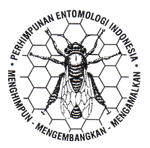The effectiveness of clove oil, its fractions, and clove oil-based fumigant tablet formulations, against Tribolium castaneum (Herbst)
DOI:
https://doi.org/10.5994/jei.18.3.191Keywords:
fractionation, mortality, naphthalene, stored product insectAbstract
Indonesia has seen an increase and widespread reports of resistance among stored-product insect pests to phosphine. The use of Syzigium aromaticum (clove oil) as an alternative fumigant may be a useful strategy to control infestation by phosphine-resistant varieties of stored-product insects. The objective of this study was to examine the effectiveness of whole (unfractionated) clove oil as well as its component fractions as a fumigant and repellent against the red flour beetle (Tribolium castaneum (Herbst)), and to develop a simple fumigant formulation for this purpose. The experimental design used to test the effectiveness of clove oil and its fractionation was a completely randomized design (CRD). Meanwhile, testing the effectiveness of tablet formulations was carried out by factorial CRD. Fumigation test results gave LD50 and LD95 values of 0.234 and 1.142 ml/l respectively, for crude clove oil used in a fumigation chamber against T. castaneum. An n-hexane fraction of clove oil tested under the same conditions was more lethal, causing 95% mortality of T. castaneum at the dose of 0.801 ml/l during fumigation. Finally, tablets containing a set proportion of clove oil and naphthalene (1:1) reached LD91 against T. castaneum after 7 days' fumigation.
Downloads
Downloads
Published
How to Cite
Issue
Section
License
Copyright (c) 2021 Trijanti Anughrahiyaharti Widinni Asnan, Sri Widayanti, Idham Sakti Harahap, Herni Widhisatuti

This work is licensed under a Creative Commons Attribution 4.0 International License.
Authors who publish with this journal agree to the following terms:
- Authors retain copyright and grant the journal right of first publication with the work simultaneously licensed under a Creative Commons Attribution 4.0 International License that allows others to share the work with an acknowledgement of the work's authorship and initial publication in this journal.
- Authors are able to enter into separate, additional contractual arrangements for the non-exclusive distribution of the journal's published version of the work (e.g., post it to an institutional repository or publish it in a book), with an acknowledgement of its initial publication in this journal.
- Authors are permitted and encouraged to post their work online (e.g., in institutional repositories or on their website) prior to and during the submission process, as it can lead to productive exchanges, as well as earlier and greater citation of published work (See The Effect of Open Access).








